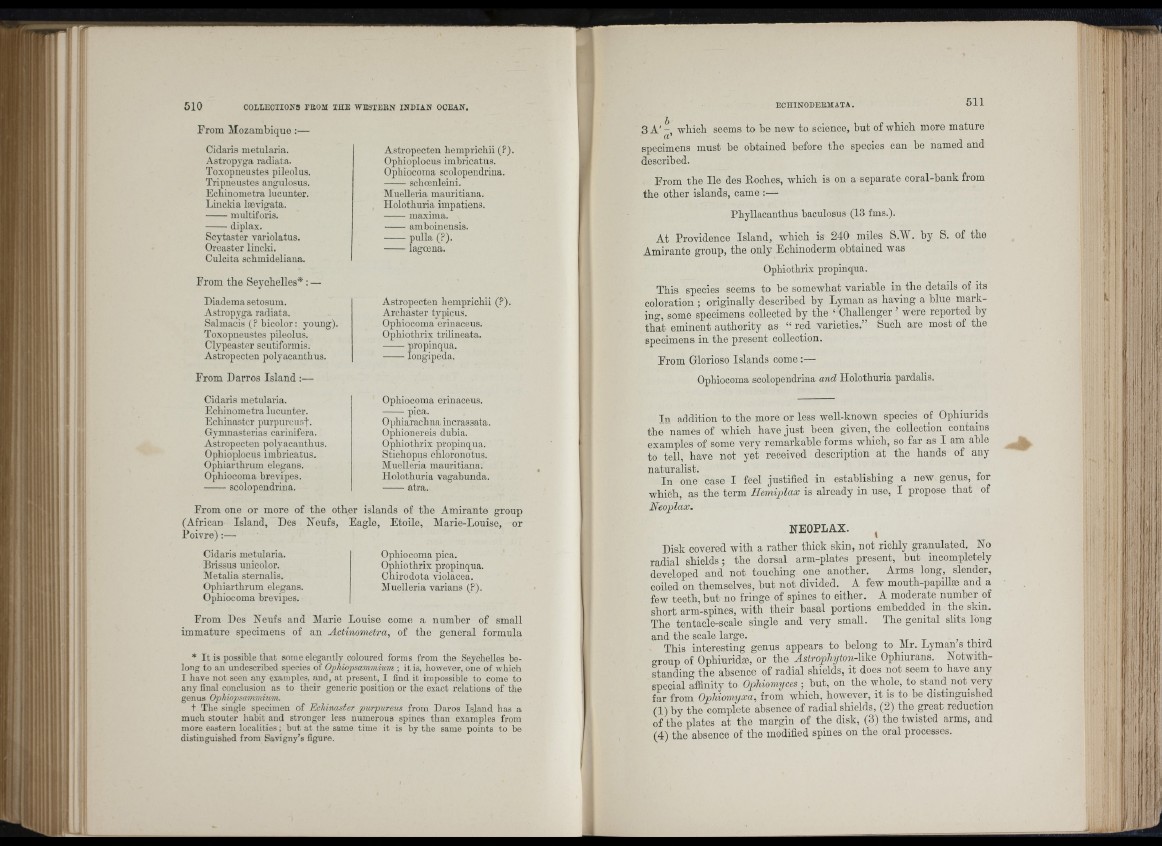
wi
l l
Ρ Iï
Iilìl
I
I r
li
i i
From Mozambique :—
Cidaris metularia.
Astrop_yga radiata.
Toxopneustes pileolus.
Tripneustes angulosus.
Ecbinometra lucunter.
Linckia laevigata.
■ multiforis.
diplax.
Scytaster variolatus.
Oreaster lincki.
Culcita scbmideliana.
Astropecten bempricbii (P).
Ophioplocus imbricatus.
Ophiocoma scolopendriua.
schoenleini.
Muelleria mauritiana.
Holothuria impatiens.
maxima.
■ amboinensis.
■ pulla (?).
• lagoena.
From the Seychelles* : ■
Diadema setosum.
Astropyga radiata.
Salmacis (? bicolor: young).
Toxopneustes pileolus.
Clypeaster scutiformis.
Astropecten polyacantbus.
Astropecten bempricbii (?).
Arcbaster typicus.
Ophiocoma erinaceus.
Opbiothrix triliueata.
propinqua.
: ongipeda.
From Darros Island —■
Cidaris metularia.
Ecbinometra lucunter.
Echinaster purpureust.
Gymnasterias carinifera.
Astropecten polyacantbus.
Ophioplocus imbricatus.
Ophiarthrum elegans.
Ophiocoma brevipes.
scolopendrina.
Ophiocoma ermaceus.
pica.
Ophiarachna incrassata.
Ophionereis dubia.
Ophiothrix propinqua.
Stichopus chloronotus.
Muelleria mauritiana.
Holothuria vagahunda.
■ atra.
From one or more of the other islands of the Amirante group
(African Island, Des Neufs, Eagle, Etoile, Marie-Louise,
or
Poivre) :—•
Cidaris metularia.
Brissus unicolor.
Metalia sternalis.
Ophiarthrum elegans.
Ophiocoma brevipes.
Ophiocoma pica.
Ophiothrix propinqua.
Chirodota violacea.
Muelleria varians (?).
Erom Des Neufs and Marie Louise come a number of small
immature specimens of an Actinometra, of tbe general formula
* It is possible that some elegantly coloured forms from the Seychelles belong
to an undescribed species of Ophiopsammium ; it is, however, one of which
I have not seen any examples, and, at present, I find it impossible to come to
any final conclusion as to their generic position or the exact relations of the
genus Ophiopsammium.
t The single specimen of Echinaster purpureus from Daros Island has a
much stouter habit and stronger less numerous spines than examples from
more eastern localities; but at the same time it is by the same points to be
distinguished from Savigny’s figure.
3 A' /-•/ ’ which seems to be new to science, but of which more mature
specimens must be obtained before tbe species can be named and
described.
Erom tbe He des Eocbes, which is on a separate coral-bank from
tbe other islands, came :—
Phyllacanthus baculosus (13 fms.).
At Providence Island, which is 240 miles S.W. by S. of tbe
Amirante group, tbe only Ecbinoderm obtained was
Ophiothrix propinqua.
Tbis species seems to be somewhat variable in the details of its
coloration ; originally described by Lyman as having a blue marking,
some specimens collected by tbe ‘ Challenger ’ were reported by
th a t eminent authority as “ red varieties.” Such are most of tbe
specimens in tbe present collection.
Erom Glorioso Islands come :—
Ophiocoma scolopendrina and Holothuria pardalis.
In addition to tbe more or less well-known species of Ophiurids
tbe names of which have ju st been given, tbe collection contains
examples of some very remarkable forms which, so far as I am able
to tell, have not yet received description at tbe bands of any
naturalist. .
In one case I feel justified in establishing a new genus, tor
which, as tbe term Eemiplax is already in use, I propose th at of
Neoplax.
NEOPLAX.
Disk covered with a rather thick skin, not richly granulated. No
radial shields; tbe dorsal arm-plates present, but incompletely
developed and not touching one another. Arms long, slender,
coiled on themselves, but not divided. A few moutb-papilla? and a
few teeth, but no fringe of spines to either. A moderate number of
short arm-spines, with tbeir basal portions embedded in the skin.
The tentacle-scale single and very small. Tbe genital slits long
and tbe scale large. , o - .
Tbis interesting genus appears to belong to Mr. Lyman s third
group of Ophiuridse, or tbe Astropliyton-li\e Ophiurans. Notwithstanding
the absence of radial shields, it does not seem to have any
special afiinity to Ophiomyces ; but, on tbe whole, to stand not very
far from Ophiomyxa, froin which, however, it is to be distinguished
(1) by tbe complete absence of radial shields, (2) the great reduction
of tbe plates at tbe margin of tbe disk, (3) tbe twisted arms, and
(4) the” absence of tho modified spines on tbe oral processes.
ite !'
'h
j!